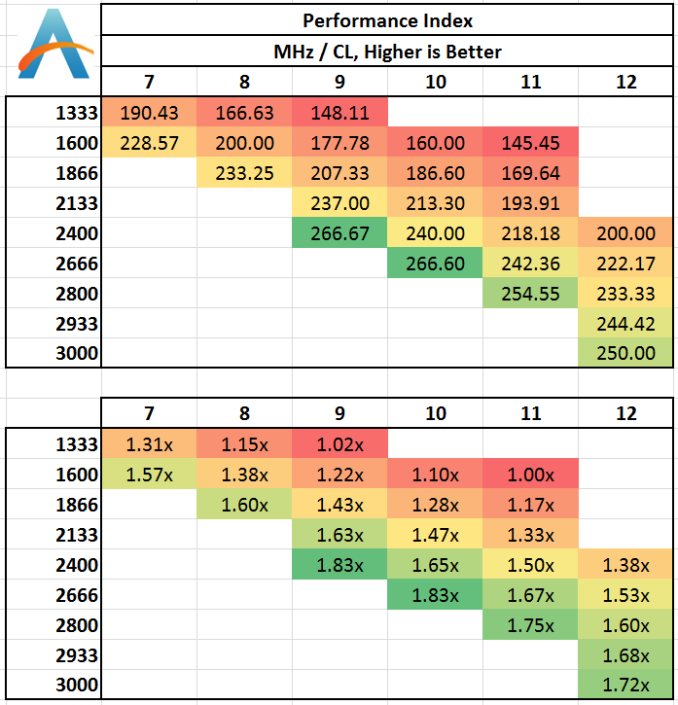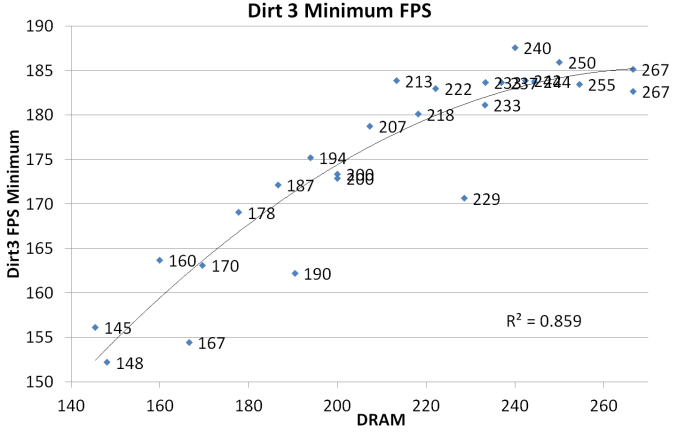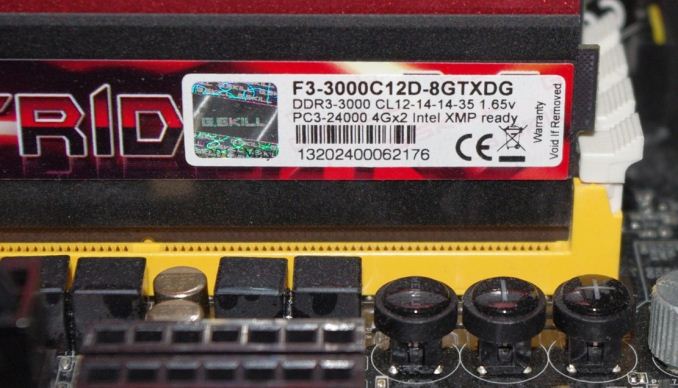Memory Scaling on Haswell CPU, IGP and dGPU: DDR3-1333 to DDR3-3000 Tested with G.Skill
by Ian Cutress on September 26, 2013 4:00 PM ESTThe major enthusiast memory manufacturers are all playing a MHz race, to retail the most MHz possible. These are pretty much all Hynix MFR memory kits, known for their high MHz, but these kits are still binned in their thousands to get one or two modules that hit the high notes. With Haswell memory controllers happily taking DDR3-2800 in their stride, it all boils down to how useful is this increase in memory versus the price at which it costs to bin and produce.
In terms of competitive overclocking, the results are real – where every MHz matters and performance is not on the menu, enthusiasts are happy to take this high end kits to over 4000 MHz+ (recent news from G.Skill shows 4x4GB DDR3-4072 in Ivy Bridge-E, the fastest result ever in quad channel). The reality of that memory is often that enthusiasts are not purchasing but are being seeded the memory, taking the cost-effectiveness out of the ratio.
In terms of real world usage, on our Haswell platform, there are some recommendations to be made.
Avoid DDR3-1333 (and DDR3-1600)
While memory speed did not necessarily affect our single GPU gaming results, for real-world or IGP use, memory speed above these sinks can afford a tangible (5%+) difference in throughput. Based on current pricing, after the Hynix fire, it may be worthwhile, as memory kits above DDR3-1600 are now around the same price.
MHz Matters more than tCL, unless you compare over large MHz ranges
When discussing memory kits, there is often little difference in our testing when comparing different Command Rate numbers – the only issues ever came along with DDR3-1333 C9 and DDR3-1600 C11, which we already suggested are best avoided. Even still, above DDR3-2400 the benefits are minimal at best, with perhaps a few % points afforded in multiple GPU setups.
However, tCL might play a role when comparing large MHz differences, such as 2400 C12 vs. 1866 C8. In order to provide an apt comparison, I mentally use a ‘performance index’, which is a value of MHz divided by tCL:
As a general rule, below 2666 MHz, my Performance Index provides an extremely rough guide as to which kits offer more performance than others. In general we see 1333 C7 > 1333 C9, but 1333 C7 is worse than 2133 C11, for example.
When presented with two kits, calculate this Performance Index. If the kits are similar in number (within 10%), then take the kit with the higher MHz. If we take the results of Dirt 3 minimum frame rates in a CFX configuration, and plot against the Performance Index listed above, we plot the following curve:
The graph shows the trend of diminishing returns in this benchmark - as the PI is higher, we reach an asymptotic limit. Note the several results below the line at PIs of 167, 190 and 229 - these are the 1333 MHz memory kits, reinforcing the idea that at similar PI values, the higher MHz kit should be the one to go for.
Of course, cost is a factor – price raises more with MHz than with tCL, thus the ‘work benefit’ analysis comes in – if buying a kit boosts your productivity by x percent, how long will it take to recover the cost? In single GPU gaming, for our setup, the benefits seemed to be minimal, but I can see workload improvements going for something faster than 1600 C9.
Remember the Order of Importance
As I mentioned at the beginning of this overview, the order of importance for memory should be:
1. Amount of memory
2. Number of sticks of memory
3. Placement of those sticks in the motherboard
4. The MHz of the memory
5. If XMP/AMP is enabled
6. The subtimings of the memory
I would always suggest a user buy more memory if they need it over buying a smaller amount of faster memory. For gamers, common advice to hear on forums is to take sum of the memory of your GPUs and add 4GB or so for Windows 7/8 – that should be the minimum amount of memory in your system. For most single GPU gamers that would put the number at 8GB (for anything bar a Titan or dual GPU), or dual GPU gamers, above 8GB (suggestion is to stick to a power of two).
G.Skill 2x4GB DDR3-3000 12-14-14 1.65V Kit: Do we need it?
Firstly, many thanks to G.Skill for the memory kit on which these tests were performed – 3000 MHz on air can be a tough thing to do without a kit that is actually rated do it. This kit has done the rounds on all the major Z87 overclocking motherboards, including the ASRock Z87 OC Formula in this test.
On the face of it, investing in this kit means a small bump to BCLK, which has additional performance gains purely based on bus speed even at a slightly lower CPU multiplier. Beyond this, there are only very few scenarios where DDR3-3000 C12 beats anything 5x cheaper – a couple of our IGP compute benchmarks, a couple of IGP gaming scenarios and a couple of tri-GPU Crossfire games as well. However, the argument then becomes if going for the extra cost of the memory is not worth buying a discrete GPU outright (or better GPUs).
The memory kit has one thing going for it – overclockers aiming for high MHz love the stuff. In our testing, we hit 3100 C12 stable across the kit for daily use, one of the sticks hit 3300 MHz on air at very loose timings, and fellow overclocker K404 got one of the sticks to 3500 MHz on liquid nitrogen. In the hands of overclockers with much more time on their hands (and knowledge of the subsystem), we have seen DDR3-4400 MHz as well.
At $690 for a 2x4 GB kit, veteran system builders are laughing. It is a high price for a kit that offers little apart from a number parade. Perhaps the thing to remember is that plenty of memory manufacturers are also aiming at high MHz – Corsair, Avexir, TeamGroup, Apacer and others. If I had that money to spend on a daily Haswell system, I might plump for 4x8GB of DDR3-2400 C10 and upgrade the GPU with money left over.
Haswell Recommendations
For discrete GPU users, recommending any kit over another is a tough call. In light of daily workloads, a good DDR3-1866 C9 MHz kit will hit the curve on the right spot to remain cost effective. Users with a few extra dollars in their back pocket might look towards 2133 C9/2400 C10, which moves a little up the curve and has the potential should a game come out that is heavily memory dependent. Ultimately the same advice also applies to multi-GPU users as well as IGP: avoid 1600 MHz and below.
One relevant question to this is whether memory speed matters in the laptop space. It remains an untapped resource for memory manufacturers to pursue, mainly because it is an area where saving $5 here and there could mean the difference between a good and great priced product. But even when faced with $2000+ laptops, 1333 MHz C9 and 1600 C9-11 still reign supreme. I have been told that often XMP is not even an option on many models, meaning there are few opportunities for some pumped up SO-DIMM kits that have recently hit the market.
Addendum:
One point I should address which I failed to in the article. XMP rating for a memory kit are made for the density of that kit - i.e. a 2x8 GB DDR3-2400 C11 memory kit might not be stable at 2400 C11 when you add the two kits together in the same system. If a kit has a lot of headroom, then it may be possible, but this is no guarantee. The only guarantee is if you purchase a single kit (4x8 2400 C11, for example) then it will be confirmed to run at the rated timings. This in certain circumstances may be slightly more expensive, but it saves a headache if the kits you buy will not work in a full density system. I would certainly recommend buying a single kit, rather than gambling with two lower density kits, even if they are from the same family. The rating on the kit is for the density of that kit.













89 Comments
View All Comments
HerrKaLeun - Saturday, September 28, 2013 - link
This was a good review. But I see one major problem for practiacl applications:Whoever cares about performace, doesn't use 8 GB of memory in the year 2013.
Even for a cheap home-built (no gaming, no CAD etc.) I used 16 GB a year ago, which cost only ~$70. when I run multiple applications in parallel (who doesn't?) W7/8 easily uses all memory for cache. Even with an SSD this is a speed advantage.
So for real world applications (running virus scan in parallel to work, 18 browser windows, watching movies etc) 8 GB re easily used up.
I would imagine a 16 GB PC (let's say ~$100) runs circles around the $700 8 GB PC in the real world.
Right now I run MSE and Malwarebytes while just using IE for browsing and I have none of my 16 GB left. The computer is not sluggish at all. I'm not sure how 8 GB RAM would work out.
One could argue most applications don't require that much memory, but running virusscan frequently should be done by all users.
I think this test should be repeated with either 16 GB or 24 GB for triple-channel platform. People interested in a few % more, also need more RAM.
Wwhat - Sunday, September 29, 2013 - link
@HerrKaLeun you say who doesn't use more than 8GB? and say you got 16GB for about 70 dollars, but this article covers a lot of extremely highly speced RAM that as stated is quite expensive, and if you bought 8GB for several hundred dollars you aren't going to supplement it with cheap high-latency low speed off-the-shelf stuff obviously.malphadour - Sunday, September 29, 2013 - link
HerrKaleun you are talking rubbish!! I have an X58 running 6gb ram and I never get anywhere near flooding it. 8GB is more tha ample for 99% of users out there. I recently built a 16gb ram rig for one of our engineers because he demanded it. To prove a point I benchmarked all our software (which includes a juicy construction CAD package) and recorded no more than a 3% performance increase going to 16gb and I put most of that down to going from single channel 8gb stick to dual channel for the 16gb. We tested render times, large drawing copies plus program open and close times with lots every peice of software on the machine running. His argument was the same as yours, and incorrect. Hardware is way ahead of the curve at the moment vs software and it will be a while before the everyday user "needs" more than 8gb.Wwhat - Monday, September 30, 2013 - link
To be fair, I hear battlefield 4 has as suggested setup at least 8GB.Like always the more RAM people on average have the more software starts to require.
ShieTar - Monday, September 30, 2013 - link
"So for real world applications (running virus scan in parallel to work, 18 browser windows, watching movies etc) 8 GB re easily used up."Because Windows will fill up all the Memory it has before even starting any garbage collection algorithms. Even today, you should be able to do all those trivial applications on 2GB of memory.
And anybody doing serious work or gaming will probably not run two major software packages at the same time. A few background programs (depending on how paranoid your companies IT department is), and a few trivial programs like browser, word processor, excel, PDF may run on the side and use up 1GB to 2GB. But nobody in his right mind will start processing of huge images in Photoshop while keeping his CAD models open in CATIA. A few nutjobs out there may run 16 installations of WoW on 16 screens with the same PC, but thats not really relevant to a general review.
So if you go and have a look again at what is tested in this review, and once you understand that any reviewer worth his salary will not go and run a dozen pieces of software parallel to the one software he is benchmarking at that moment, it should be clear at the very least that repeating above benchmarks with 16GB will give you absolutely no difference in the benchmark results whatsoever.
Chrispy_ - Sunday, September 29, 2013 - link
So the the three common scenarios are::
--- 1. You want an IGP ---
Get the cheapest RAM, If you buy significantly better RAM the cost of APU + RAM becomes more than the cost of a normal CPU + dGPU + cheap RAM, which is obviously much higher.performance.
:
--- 2. You want a single graphics card ---
Spend the money you're *thinking* about spending on better RAM on a better graphics card. If you want a decent dGPU then you're most likely a gamer and even 1600MHz CL9 is fine, but you'll see a big improvement if you move from a $200 GTX660 to a $250 660Ti
:
--- 3. You want more than one graphics card ---
Divide RAM Frequency by CAS Latency to get the actual speed, I've been doing this for years and I'm glad Ian has finally mentioned this in an article.
ShieTar - Monday, September 30, 2013 - link
I don't think anybody would disagree with the general direction of your comment, but you seem to overestimate the exact differences in cost for 8GB of RAM these days. A quick check (for Germany) gives me the following price differences for RAM frequency (relative to 1333):1600 : -0.50€ (No-Brainer)
1866 : +1€
2000 : +20€
2133 : +10€
2400 : + 8€
2666 : +50€
2933 : +170€
So, for 8€ you can pick 2400 instead of 1600, which would give you a significant increase in performance should you ever find a piece of software that heavily depends on memory transfer rates. You are very unlikely to step up your CPU or GPU model for that kind of price difference.
Latencies can be similar. For DDR3-1600, going from CL11 to CL9 will cost you about 2€ to 3€. Of course, at that point you still have a higher latency than DDR3-2400 with a CL11, so that seems to make the most sense right now for price to value ratio.
rootheday3 - Sunday, September 29, 2013 - link
Hd4600 is likely not memory bottlenecked with 20 eus at stock igp frequencies. There is a reason that intel didn't add the EDram to skus other than the 47w+ gt3e 40eu skus, 4 samplers and 2pixel hacienda. For a gt2 with half the assets, memory is not the issue- 1600mhz in dual channel is plenty. For people who were asking earlier in the thread, dual channel vs single channel is ~15-30% impact on gt2.If you want to see more sensitivity/ scaling with memory, you would need to OC the igp first.
Or, as others said, test on skus that are more likely to stress memory - like gt3e (iris pro 5200) Note that hd5000 (15w package tdp) and iris 5100 (28w tdp) may be tdp bound on most workloads, so even there you may not see scaling with memory beyond ~1600-1866 dual channel.
Note that Trinity/Richland are more sensitive to memory (especially on 65-100w desktop skus) because they don't have the LLC to buffer some of the bandwidth demands.
malphadour - Sunday, September 29, 2013 - link
I have mushkin 6-8-6-21 1600mhz which seems to be almost unique (don't think I have seen nayone else make cl6 at this speed) - would be interested to see if CL6 at 1600mhz was a match for much higher mhzmalphadour - Sunday, September 29, 2013 - link
I think the comment 1600mhz is bad can be taken with a pinch of salt here. Depends on who the PC is for. If it is normal use then 1600mhz cl9 is going to be fine all day long. Ian's point is, I think, aimed at the enthusiast who is benchmark chasing, in which case bigger is always better. It would be nice if hte price of ram had not doubled. I was buying 8gb 1600mhz cl9 for £29.99 not too long ago, two recent builds it is as £54.99, nearly twice the price in the UK :(